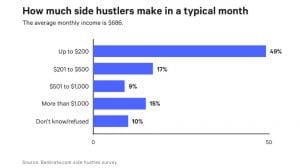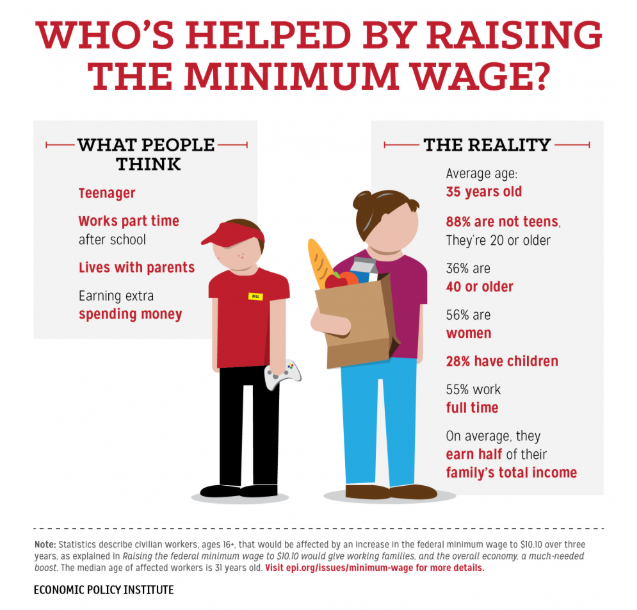Would you like Taco Bell delivered to you? Could your dog Fido use a midday walk while you’re at work? Maybe enjoy your Saturday morning and let someone else shop for and deliver your groceries? Just about any service you need to free up time and make your life easier can be provided in today’s thriving gig economy. According to a Bankrate.com study, 37% of Americans have a side hustle to supplement their full-time incomes. Some people even choose to work several side gigs instead of a traditional full-time job. These personal luxuries are creating a growing gig economy that is impacting small business owner’s ability to attract good workers.
The Side Hustle Dilemma For Small Business Owners
Side hustles are not a new phenomenon. People have moonlighted as long as work has been around. But smartphone apps have created a new hyper-connected “sharing economy” that makes side work so much more accessible than at any other time in history. Workers have more options to earn extra money at their own pace and schedules. Under the heading “How Does This Work”, the grocery delivery service, Shipt, states, “Shipt Shoppers set their own schedules according to their busy lives! They shop for and deliver groceries to Shipt’s members within a requested time frame. Scheduling, accepting orders, and shopping orders are all done through the Shipt Shopper app.” This appealing proposition poses a challenge for small business owners who depend upon part-time hourly workers. The chart below is from the Bankrate.com study and shows that 49% of side hustlers earn up to $200 a month and 41% (combined total) earn greater than $200 a month.

In a different study by Sidehustlenation.com, who sent out a survey to its 65,000 subscribers and received more than 1600 responses, they found that their subscribers work about 11 hours a week and earn over $12,000 a year. That’s about $25 per hour. Maybe that is a high figure because these are ambitious people who subscribe to a side hustle blog to learn how to tweak and improve on their side hustle skills. So, let’s go with half that number and $12.50 per hour. As a small business owner who needs part-time hourly employees, that’s a hard number to match. In addition, you have payroll taxes and worker’s comp. In our recent post, Is There a Better Way to Pay Your Employees? , we reported that the U.S. unemployment rate is at historical lows. With low unemployment and more Americans choosing side hustles instead of traditional jobs, how do you, the small business owner, maintain a strong and steady workforce?
3 Ways for Companies to Compete With the Gig Economy
Perk Up
The Sidehustlenation.com survey reported that half of the respondents “loved” their full time jobs, but 76% loved their side hustle. Do what you can to make your company a place where people love to work. Offer tangible perks or incentives to reward good employees. The gig economy gives people choices. Give reasons to make the best candidates choose you. Who doesn’t like to go out to eat? Give restaurant gift cards as perks. Many established restaurant chains will give you a kickback bonus for a certain amount of gift cards purchased. Reward your employees, reward yourself. Another suggestion since this is a second job, give your employees something they probably desperately need – time off – paid! Be creative. A completely free way to “perk up” your employees is to find opportunities to praise them. A kind word goes a long way.
Mix It Up
Shipt really nailed it on their website with “Shipt Shoppers set their own schedules according to their busy lives!”. A side hustle offers flexibility for people to set their own schedules. Rover, the online marketplace for people to find local pet sitters, tells sitters that they can set their own schedules and prices. Depending on your industry, this idea may not work for you, certainly not for lifeguards and security officers. But if you own a janitorial company that does night cleaning when the offices are closed, can you give your employees the option to clean anytime between the close of business and say 11 pm? Or maybe you are a garden merchandising company, can you offer good candidates the ability to get their work done during any open hours of the store? We can help you provide this freedom and still ensure that your customers don’t miss a service. You can create work schedules for your employees that will send you no-show alerts at your “drop-dead need to know” time. Flexible work schedules are a tangible benefit for employees and provide job security that they may not feel with a side hustle.
Pay Up
This one, at first glance, may seem hard to swallow or imagine. You already feel strapped. But the cost of high turnover may be more expensive in the long run. You suffer a loss in productivity. You spend time and money recruiting, interviewing, and training new employees. For example, it’s estimated that employee turnover in the janitorial industry is 200% and it costs $1000 to replace an employee. If a company needs to maintain 50 employees, it will hire 100 new employees every year at $1000 each. That’s $100,000 in annual costs that eat away at the bottom line without benefiting the company with new technology, equipment, or marketing channels. The foundation of the service industry is hourly employees and in the lower-paying sectors, employees will switch companies for fractional pay increases. According to a report by Betterment.com, 72% of people who supplement their full-time incomes with side hustles do it to pay off debt. So every penny matters to them. Let’s say that you are the owner of a 50 part-time employee cleaning company. Each employee averages 20 hours a week. A $1 per hour raise comes to $50,000 per year. If that pay raise (or higher starting wage) cuts your turnover rate in half, that’s a $50,000 savings in hiring expenses. Your payroll and recruiting expenses are still the same, but you are saving on recruiting and training time and lost productivity. It’s an overall win. Pay more, implement the other ideas suggested here, and dramatically cut your churn rate. Keep productivity high, customers happy and your bottom line solid.
On a final note about paying more, the following infographic shows who you would benefit by offering a more competitive wage (while we aren’t saying we support the idea of the government raising the minimum wage, we do think it’s great when companies take their own initiative to do it). The “Reality” side possibly represents great candidates for your business.

Final Thoughts
The gig economy is not going away. Savvy entrepreneurs will continue to brainstorm creative ways to make life easier for those willing to pay for the services. These innovations will lead to more opportunities for Americans to choose not to work traditional part-time low paying jobs. Small business owners need to step it up and be just as creative in finding ways to attract these workers.
Stay tuned and stay in touch by following us on Facebook.
